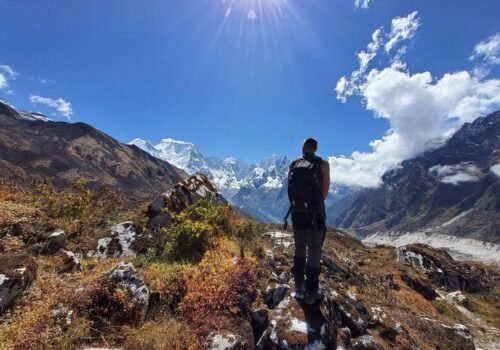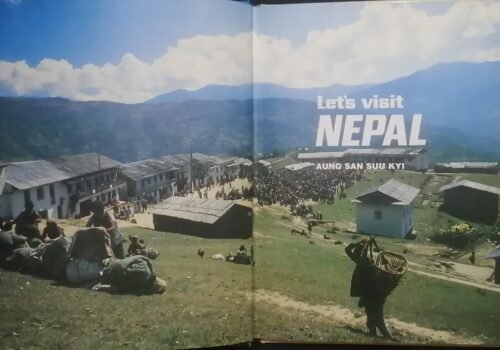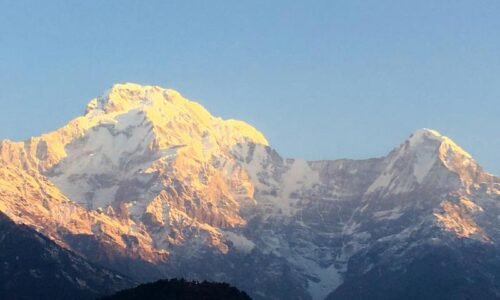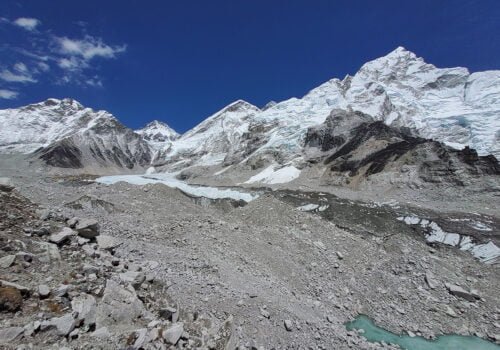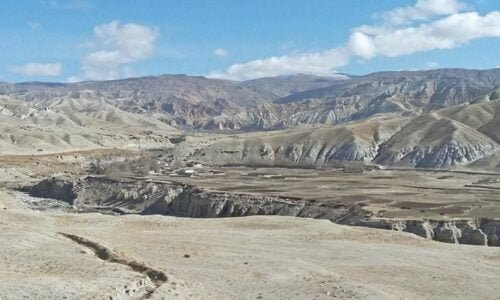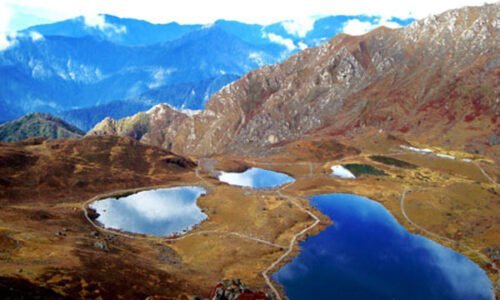Great Nepali Festivals
17 Oct 2022 21 min to read
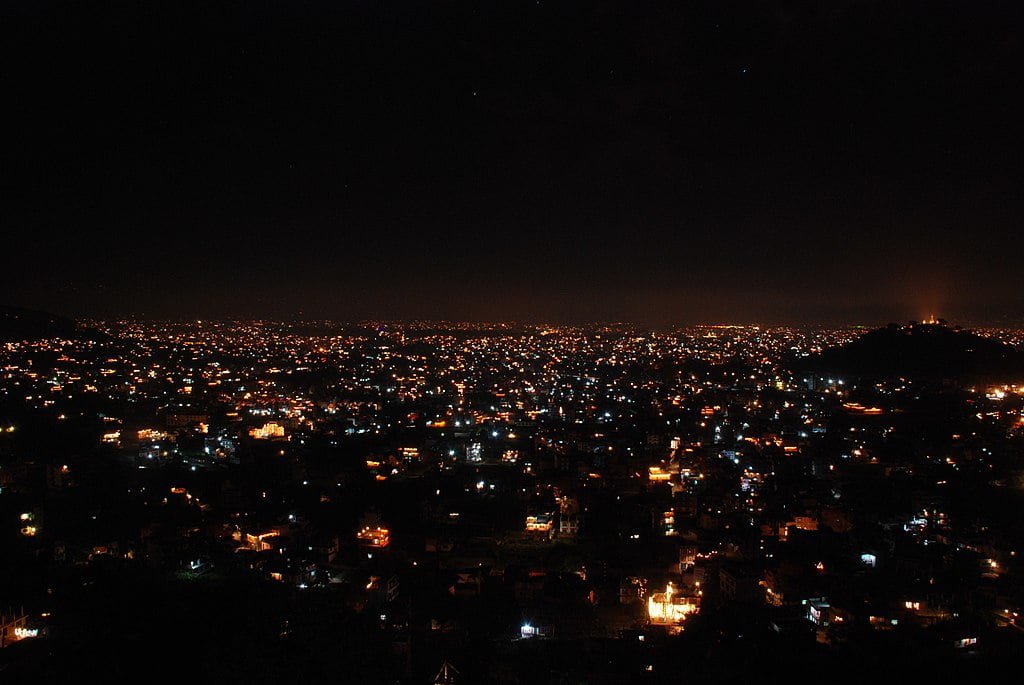
The land-locked nation of Nepal is wonderful in every aspect. Nepal is a multi-racial, multi-religious, multi-lingual, multi-cultural, and Geographically diverse nation. So, many diversities in one place make Nepal distinctive. The diverse ethnic community performs diverse rites and rituals. Nepali people also celebrate several festivals that follow their culture, tradition, and religion. Nepal is one of the few nations in the world that respects each other’s culture and tradition, & celebrates Nepali festivals with great happiness. The great Nepali festivals lure every traveler around the world as they have both historical and cultural significance.
One of the surprising facts about Nepal is that people celebrate more than 50 festivals in a single year. This shows the great belief of Nepalese in their culture, tradition, and religion. According to the census report of 2021, there are 124 languages, 142 ethnic groups, and 10 religions in Nepal. Another interesting fact about Nepal is that it celebrates its festivals based on the Nepali lunisolar calendar (Bikram Sambat) and some in Nepal Sambat (used by Newar ethnic). Bikram Sambat and Nepal Sambat are both official national calendars of Nepal. Hence, the festival dates may vary in Nepal. Some of the great festivals celebrated each month are described below:
January/February
Maghe Sankranti
Maghe Sankranti is the festival celebrated as the beginning of auspicious days and the end of the winter season. It always falls on the 1st day of the Magh month. It is also known as Makar Sankranti. The different ethnicities of Nepal celebrate this festival in different ways. Newar people called it Ghya: Chaaku Sanhu. Tharu community celebrates it as Tharu New Year and called it Maghi.
The Kirat and Magar community also celebrate this festival in their traditional way. People worship the Sun god and take a bath in the holy rivers of Nepal. Various fairs are organized at the banks of the river. Dolalghat, Baraha Kshetra, Ridi, Trivenighat, etc are some famous places for taking a holy bath. People enjoy eating Ghee, chaaku (molasses), yams, sweet potatoes, til laddoo (black & white sesame fudge), and khichdi which are the prime dishes of this festival.
Sonam Losar
Sonam Losar is the Tamang New Year. Tamang and Yolmo communities celebrate this festival. They celebrate this festival after harvesting the crops. The 12 different months indicate 12 different animals. People visit monasteries, and stupas and perform rituals. They participate in cultural programs by wearing traditional dresses, and jewelry, playing traditional musical instruments Damphu, exchanging greetings, and enjoying a delicious feast and main dish Khapsey.
February/March
Maha Shivaratri
The greatest Hindu festival Maha Shivaratri is dedicated to Lord Shiva. The festival is celebrated in the vicinity of Shiva Temples inside the country. Pashupatinath Temple in Nepal witnesses thousands of devotees from different parts of the world. Shivaratri means the night of Shiva and is termed the wedding day of Lord Shiva and Parbati.
People celebrate this festival by keeping a night-long fast and performing Maha Aarti, rituals, and pujas. People worship Lord Shiva with sandalwood paste, Bael Patra, Dhaturo, fruits, and milk. Many Sadhus chant Shiva mantras. People eat halwa-puri and drink bhang as Prasad. Married women worship Lord Shiva on this day for the long life of their husbands. Unmarried women worship for getting an ideal husband like Lord Shiva.
Basanta Panchami/Saraswati Puja
Basanta Panchami also called Saraswati Puja is the day of worshipping the goddess Saraswati (knowledge and wisdom goddess). It marks the day of welcoming Spring month. On this day, people worship the goddess Saraswati and visit the Saraswati temples. They offer fruits and food items in the temple. The small kids write their names or alphabet on this day. It is believed that kids writing on this day can learn quickly.
Gyalpo Losar
Gyalpo Losar is the New Year of the Sherpas. They celebrate this festival for 2 weeks following a traditional ritual. The initial days are the main days. They prepare a traditional beverage Changkol on the first day. The second day is the start of the New Year i.e. Gyalpo Losar. On the 3rd day, they attend various cultural programs, perform traditional masked dances, visit monasteries, and wear traditional dresses and jewelry. They celebrate the day by enjoying Khapsey and other food items, drinking Changkol, and gathering with family and friends.
Holi
The most vibrant and colorful festival in Nepal is Holi. The great festival is the start of the spring season. Many ancient tales are linked with this festival. Hence, the culturally important festival is celebrated as the triumph over the bad. People also called it Phagu, Phaguwa, or Hori. People celebrate this festival by applying various colors on the face of their family, relatives, and friends. They also splash water and throw water balloons.
Inside Kathmandu city, a huge Holi festival is organized around Basantapur Durbar Square. As per the traditions of the Newar community, the auspicious Chir gaadne (pole set up) ceremony is done a week before the main festival. A large number of tourists gather around Basantapur to witness and celebrate this festival. Holi is celebrated for two days in Nepal. The people of the Hilly region celebrate this festival on the first day. The next day, the people of the Terai region celebrate this festival with great excitement. They drink Bhaang/Thandai as a Prasad. They apply colors, dance, and spend a good time with near and dear ones.
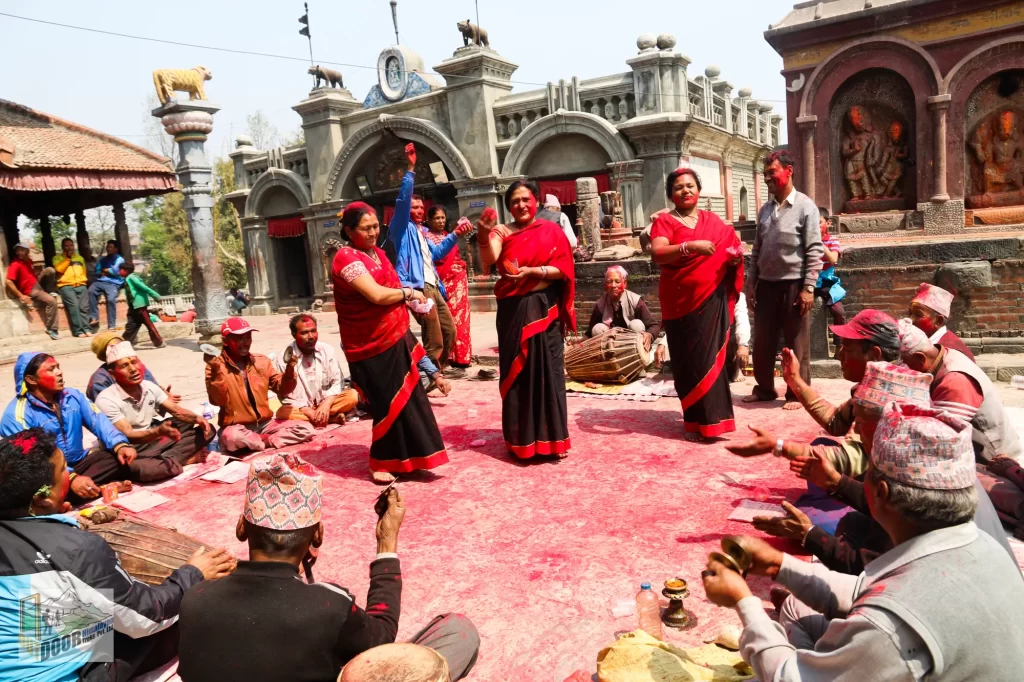
March/April
Ghode Jatra
Ghode Jatra is a horse parade festival organized in Tundikhel, Kathmandu. Nepal Army organizes horse competitions and parades. It is organized to celebrate the victory over the evil demon. People worship various deities and offer bhog at Tundhikhel to the evil demon.
The day before Ghode Jatra, the Newar community celebrates Pahan Charhe. Pahan means ‘guest’ in Nepal Bhasa, while Charhe is the 14th day of the dark fortnight of Chillā, (5th month in Nepal Sambat), when the festival begins. The big festival of Newars where they invite their relatives and other members for a feast.
Chaite Dashain
Chaite Dashain is the celebration of victory over evil by Lord Ram. It is celebrated for two days. People visit Ram, and Durga temples, keep fast, and celebrate it. They offer fruits and worship the deities in the temple. Some people also visit pilgrimages. The second day of Chaite Dashain is called Ram Navami. The birthday of Lord Ram is on this day. So, it is celebrated in all Ram Temples with full devotion and joy.
Seto Machhindranath Jatra
Seto Machhindranath, a revered deity in Kathmandu, is worshipped by both Buddhists and Hindus. Seto Machhindranath Jatra is a 3-day chariot festival held on the 8th day of Chaitra Shukla Ashtami. The deity protects against diseases and symbolizes righteousness and the spiritual realm. The chariot procession carries the idol from Machhindra Bahal to Jamal, concluding at Lagan Tole. The next day, the idol is returned to its original location at Jana Bahal.
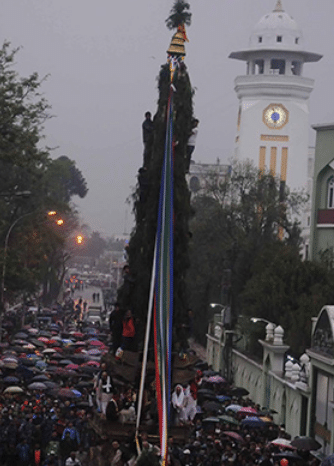
April/May
Nepali New Year
Baisakh 1st is Nepali New Year’s day. It falls in the English month of April. All Nepalese welcome this New Year with great happiness. There is a public holiday. So, many people spend the day with family members, friends, and relatives. Many travels to new destinations, visit new places, prepare a feast, go on a picnic, or enjoy the food in restaurants/hotels. People also attend concerts on this day. People spend quality time with their loved ones.
Bisket Jatra
Bisket Jatra is the famous long chariot festival in Bhaktapur city. It is the symbol of victory over bad things. The people of Bhaktapur grandly celebrate this festival. The ceremonial pole is constructed, a chariot procession with the idols of Bhairavas, and observe tongue-piercing Jatra, and sindoor (vermillion) Jatra. People play various musical instruments, sing, dance, and spread colors. They worship various idols and visit temples. They create great memories with this festival.
Rato Machhindranath Jatra
The longest Newari chariot festival which is organized in Patan is called Rato Machhindranath Jatra. The Newari people called it ‘Bung Dya: Jatra’. The festival is celebrated to worship the deity of rice grains ‘Rato Machhindranath’. Upon the appearance of Rato Machhindranath in Nepal, it is believed that the problem of rainfall and rice grain harvest was solved. Hence, the Rato Machhindranath chariot procession takes place to celebrate the rainfall and rice grain harvest.
The chariot procession takes place in the several streets of Patan. Several people participate in this chariot procession and they also pull the chariots. Bhoto Jatra (traditional vest) is also displayed at the end of the Rato Machhindranath Jatra on the advice of astrologers on an auspicious date.
Eid-al-Fitr
Eid-al-Fitr is the holy Muslim festival that takes place for 3 days in the month of Ramadan. It usually starts at Shawwal, the 10th month of the Islamic calendar. It starts on ‘Chaand Raat’ (the first arc moon). The festival is celebrated to mark the end of Ramadan month and the end of the fast. Muslims thanked ‘Allah’ for the ‘Quran’ and the strength of fasting throughout the month of Ramadan. All families and friends gathered at one place/spot on the last day of Ramadan to view the new moon. Then, they wish each other, enjoy a feast, visit relatives, and celebrate it with great happiness.
May/June
Buddha Jayanti
Buddha Jayanti is celebrated as Lord Buddha’s birthday in different places. Vesak, Buddha Purnima and Swaya Punhi are some other names of Buddha Jayanti. Different functions and programs are organized in the Lumbini (Buddha’s birthplace), Bouddhanath Stupa, Swayambhunath Stupa, various Vihars, Chaityas, and Buddhist monasteries.
Not only Nepalese but devotees from different parts of the world participate in this festival. Many visitors visit the stupas, and monasteries and ignite butter lamps, and incense, decorate houses with Buddhist flags and listen to the sermons on Lord Buddha’s principles, and teachings by preachers. Buddha Jayanti is auspicious because of Lord Buddha’s Birth, Enlightenment, and Maha Parinirvana on the same day. People enjoy Kheer (rice pudding), puri (fried bread), and tarkari (veg curry) on this day. Most people prefer to eat vegetarian food on this day.
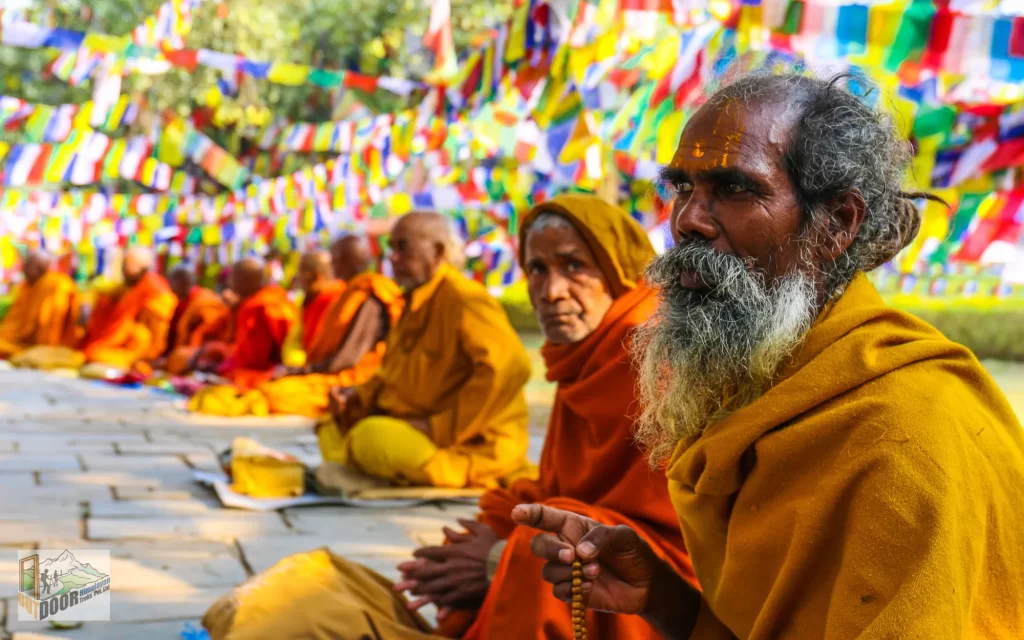
June/July
Bakra Eid
Bakra Eid is also called Eid-Al Adha, Eid Qurban, and Qurban Bayarami. The second most important festival of Muslims is celebrated by attending a special ‘namaz’ at mosques. It falls on the 10th day of the Islamic month of Dhu al-Hijjah. It is celebrated before the sun enters the ‘Zuhr’ or mid-day prayer time. They attend the sermons by the Imam or Khutbah. Muslims perform ‘Qurband ani’ by sacrificing a goat or lamb as a devotion to Allah. Muslims wear new clothes, exchange wishes, & gifts, do charity, organize a grand feast, and celebrate with family, friends, and relatives.
Asar 15 (Dhaan Ropai)
Asar 15 is the National Paddy Day in Nepal. This day is also called ‘Dhaan Diwas’ and ‘Dhaan Ropai Jatra’. A great festival for farmers. As Nepal is an agricultural nation, this day is very significant. Farmers celebrate this day by planting paddy, plowing the field, singing traditional Assare songs, and dancing on the muddy field. They plant paddy with the hope of good harvesting. The grains are considered Goddess Annapurna. Thus, farmers pray and worship for good harvesting of crops on this day. The main dish on this day is Dahi Chiura (Yogurt/Curd and Beaten rice). People enjoy dahi-chiura after planting a paddy. Nowadays, many tourists also participate in this unique festival.
July/August
Guru Purnima
Guru Purnima is a traditional festival that is celebrated in honor of the teachers, leaders, or gurus. In Sanskrit guru means ‘One who removes the darkness of our ignorance’. Many schools celebrate this festival with great excitement and happiness. All teachers are felicitated and offered garlands, gifts, and delicious feasts. Various cultural functions are performed by students to honor the teachers. Not only in schools, all people who considered one as their teacher visit or wish them on this day. A great day for teacher-student bonding.
Ghantakarna Chaturdashi/Gathemangal
Ghantakarna Chaturdashi is a festival celebrated to mark the end of the negativity and cruelty of a demon named ‘Ghantakara’. Newar community called it ‘Gathemangal’. People celebrate this festival by making a demon effigy with straw, green leaves reed, and a picture of a demon or demon-like mask. The effigy is toured around the streets and in the evening it is burnt down in the middle of the street.
People also wear iron rings on their fingers to ward off evil demons and spirits. Some people donate with the belief of getting free from evil spirits. Newar community people clean their houses and prepare delicious feasts. They worship in the night, keep iron nails on each house’s doors, and put a worshipped pot full of meals in the middle of the street. Then, enjoy the feast with family members.
Naag/Nag Panchami
Naag/Nag Panchami is a traditional festival of worshipping the deity snake. There are many ancient tales related to Naag Panchami. One is that many snakes used to live in a big lake in the Kathmandu valley. When people started settling down removing lakes, snakes became furious. To protect themselves from the anger of Naag, people started worshipping naags which is continued to till date. It is also celebrated to restrain evil/bad spirits.
On this day, people worship the naag by sticking Naag pictures with cow dung above the front door. They worship it by sticking rice paste, offering cow’s milk, putting cotton garlands, red tika (vermillion), and other holy items. They also keep milk in a bowl near the snake holes. Naag Panchami is also celebrated for the blessings of good health.
Janai Purnima/Rakshya Bandhan/Kwati Khane
Janai Purnima is observed by changing the old Janai and wearing a new Janai from the hands of a priest on this day. ‘Janai’ is a sacred cotton string worn across the chest by Hindu males. Hindu males take a dip in a holy river thrice or take bath before changing Janai. The sacred string symbolizes body, speech, and mind, and is believed to attain complete control over it by wearing it.
On this day, ladies and gents tie a holy colorful (yellow, orange, or red) knot called doro for security and purity. They take it as good fortune. Mostly Hindus tie the knot around their hands performing rites and rituals and chanting mantras. They prefer eating Sattvic foods. This day is also called Rakshya Bandhan. Sisters also tie colorful Rakhi around their brother’s wrists on this day. An auspicious festival to celebrate as the protection, and strong bond between brothers and sisters.
Newar community called this day ‘Gum Punhi’. The community celebrates this day by eating Kwati. Hence, it is also called Kwati Khane din (eating day). A kwati is a special soup prepared with a mixing of 9 types of beans. It includes black gram, green gram, chickpea, filed bean, soybean, garden pea, field pea, rice bean, and cowpea. Newari Farmers celebrate this festival by offering kwati and rice to the frogs as gratitude for being gentle and spelling rain for farming. Kwati is a good source of energy and nutrients which is good for health and immunity boost.
Gai Jatra
Gai Jatra is a unique and significant festival that is celebrated in the respect of immediate families or relatives who have deceased during the last year. This is a Newari festival and is popular as ‘Sa Paru’. The festival is celebrated grandly in different cities of the Kathmandu valley. The festival has continued for many generations. The children disguise themselves as cows and parade the street in the morning. Other locals and relatives offer or donate fruits, sweets, biscuits, and other food items to the children to complete the parade without being hungry.
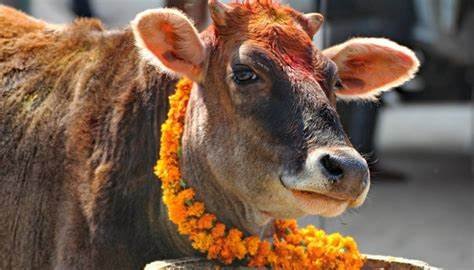
August/September
Krishna Janmashtami
Krishna Janmashtami is the birthday celebration of Lord Krishna. The Hindus celebrate this festival with great devotion. The various Krishna Temples in the country are decorated. The crowd of devotees visits Krishna temples for worship. Many devotees keep fast and perform bhajan, and kirtans in the Krishna temple. Khoa and Panchamrit are offered to Lord Krishna. They end their fast at midnight by eating Prasad offered to Lord Krishna.
Teej
Teej is a Hindu festival celebrated mainly by women for the longevity of their husbands, steady relationships, and purification of oneself. It is also called Haritalika Teej which lasts for 3 days. Teej is believed to be the Lord Shiva-Parbati union. Unmarried women also celebrate this festival to get a good future spouse. Both married and unmarried women kept fast on the main day.
On the first day, women participate in various functions, eat dar (special Teej feast), sing and dance to a cultural song, and wear sari and ornaments. The women kept the fast on the second day. They don’t drink a single drop of water the whole day. On the 3rd day, they take a bath, complete the puja/rituals, and end their fast.
Rishi Panchami
Rishi Panchami is a traditional Hindu festival celebrated by women by worshipping 7 sages called Sapta Rishi. The 7 sages are Kashyapa, Atri, Vishwamitra, Bhardwaj, Gautama Maharishi, Jamadagni, and Vasistha. Women take a ritual bath in holy rivers, ponds, and water bodies. Besides, Sapta Rishi, Arundathi, Lord Ganesh, & Navagraha (9 planetary deities) are worshipped. It is a big festival for women and they celebrate with the belief to get rid of the sins committed during the periods.
Indra Jatra
Indra Jatra is an ancient important festival inside the Kathmandu valley celebrated by the Newar community. The festival is dedicated to the rain and harvest God Indra. The Newars called it ‘Yenya’ which means the celebration of Kathmandu. The eight-day-long festival observes the setup of Ya-Sheen (Indradhoj Lingam) on the first day. Newar community people tour the streets of Kathmandu igniting diyo in the name of deceased family members. They called it ‘Upaagu Wonegu’.
On other days, people witness several masked dances, lakhey dances, displays of Bhairava idols in the streets, and Kumari Jatra (chariot procession of Living Goddess Kumari) around the Kathmandu Durbar Square. The VIPs of Nepal (President, Prime Minister, Foreign Diplomats, etc.) observe the Kumari Jatra from the Gaddi Baithak. Various traditional instruments are played. The taking-down of Ya-Sheen marks the end of Indra Jatra.
September/October
Dashain
Dashain is the main and biggest Hindu festival in Nepal that lasts for 15 days. Dashain is one of the Great Festivals in Nepal. This auspicious festival is celebrated by both Hindus and Buddhists of Nepal following their culture and tradition. Newar Buddhists called it Mohani. The festival symbolizes victory over bad/evil. Ghatasthapana is the first day of Dashain where jamara seed is planted in a holy pot. The Navarati also begins on this day. Phulpati, Maha Ashtami, and Maha Navami are 7th, 8th, & 9th days of Dashain where people visited various Durga temples and perform rituals.
Vijaya Dashami is the 10th and the main day of Dashain. Juniors seek blessings from seniors and put tika, jamara, mohani tika by newars (black tika), and red string on their necks. They also receive Dakshina (money) on this day. The whole family gathers together and enjoys a feast, drinks, plays cards, sings, and dances. The last day of Dashain is called Kojagrat Purnima. People visit their relatives to put tika to till this day and seek blessings.
October/November
Tihar
Tihar is the second big Hindu festival in Nepal. It is also celebrated by both Hindus and Buddhists. Newar Buddhists called it Sunti. Tihar is popular as the festival of lights. It is celebrated for 5 days. The 1st day is Kaag (Crow) Tihar. People worship crows and offer rice and grains to them. The 2nd day is Kukur (Dog) Tihar. People worship dogs by putting a garland on their neck, tika on their forehead, and offering treats.
Gai (Cow) Tihar & Laxmi (Goddess of wealth) Puja is the 3rd day. People worship cows and feed them various food items in the morning. In the evening, people cleaned their houses. They lit a diyo and decorated the Laxmi with lights, fruits, nuts, and sweets. They worship the goddess Laxmi for prosperity and happiness.

Govardhan (Ox) Puja is celebrated on the 4th day. The Ox is worshipped and fed with food items, a garland on its neck, and a tika on its forehead.For the Newar community, it is the day of Newari New Year i.e. Nepal Sambat and Mha Puja. In the morning, they parade around Kathmandu Durbar Square and organize rallies and cultural functions. In the evening, they celebrate Mha Puja. A celebration of one’s body and inner soul for purification.
The final day of Tihar is Bhai Tika. A festival where sisters worship brothers and pray for their good health and long life. The sisters put a saptarangi (7-color) tika on their forehead and a special Makhmali garland on their necks. Brothers give gifts to their sisters and bend to sisters’ feet for blessings. Rani Pokhari in Kathmandu opens on this day. Many brothers having no sisters visit this temple on Bhai tika. People enjoy this 5-day festival by decorating the street with lights, playing deusi-bhailo, cooking sel-roti (round fried bread), and eating a delicious feast.
Chhath Parva
Chhath Parva is the sun deity worshipping festival. Chhathi Maiya, the sister of the deity Sun is also worshipped. The Parva lasts for 4 days. Nahay Khay, Kharna/Lohanda, Sandhya Argha, and Usha Argha are the main rituals performed on these 4 days. The Sun is a deity of wisdom, longevity, and energy. Likewise, Chhathi Maiya is a deity of good health and protection from illness. Chhath Parva is grandly celebrated in the eastern region of Terai. Many fairs are organized.
People take a bath in the Holy River, pond, or lake, keep fast, and offer prayers & Surya Namaskar to the rising and setting sun. They prepare special bhogs and offer them to god. Later, distribute to the family members as Prasad. Chhath Parva is celebrated for the good health blessings and long life from the sun deity and Chhathi Maiya.
November/December
Vivaha Panchami
The grand wedding of Lord Ram and Mata Sita is called Vivaha Panchami. The festival has huge significance in Janakpurdham of Nepal. Numerous devotees from different parts of the country and India visit Janakpurdham on this day. People decorate the sacred temples of Lord Ram and Mata Sita and observe the Vivaha Utsav with great pleasure.
Lord Ram is represented as Shaligram Shila and Mata Sita as Tulsi plant and the wedding is performed between them. People offer garlands, tikas, white flowers, bhog of sabudana & kesar. After the completion of the function, bhog is distributed as a Prasad to the devotees. On this day, the city is beautifully decorated with lights.
Bala Chaturdashi
Bala Chaturdashi is a seed sowing festival in the name of deceased loved ones, family members, and relatives. It is performed in the belief of securing a good place in heaven for deceased ones. The festival is celebrated by performing rituals, sowing seeds, and circulating the Shiva idols and other temples around the Pashupatinath temple. During this festival, take a bath at holy Bagmati river, people chant mantras, lit a diyo (oil lamp), and sow satbij (mixture of 7 holy seeds).
December/January
Udhauli Parva (Yomari Punhi)
Udhauli Parva is a Kirati festival that marks the arrival of the winter season. They show gratitude towards Mother Nature for providing good crops. They celebrate this festival by performing traditional Sakela dance in a circle with a musical beat of Jhyamta, Dhol, and other musical instruments.
The Newar community also celebrates this day as Yomari Punhi. Yomari is a fish-shaped dough confection prepared of rice flour from the new harvest, molasses, or khoa by steaming. Molasses is a mixture of brown sugar and sesame seeds. The Newars of Kathmandu Valley worship the grain goddess Annapurna for the new harvest and offer the first Yomari as a bhog. The Newar villages of Hari Siddhi and Thecho celebrate this festival by performing masked dances.
Tamu Losar
Tamu Losar is a Gurung New Year celebrated by the Gurungs on every Poush 15th (Dec/Jan). Gurungs celebrate this festival by wearing traditional dresses and ornaments. Men wear Bhangra and women wear Ghalek. They perform traditional dances, organize feasts, and cultural programs, drink homemade alcohol, and enjoy.
Christmas
As stated earlier, Nepal is a multi-religious nation. People here celebrate Christmas very joyfully. As Christmas is a celebration of birth of Jesus, Nepali Christians attend the church for prayers and celebrations. They decorate Christmas trees and exchange gifts, cards, and wishes. They play music, sing a song, and dance with friends and families also they share delicious meals and spend the day performing various activities. The function starts on Christmas Eve (Dec 24) and continues for the whole next day i.e. December 25th.
Updated: May, 2023
